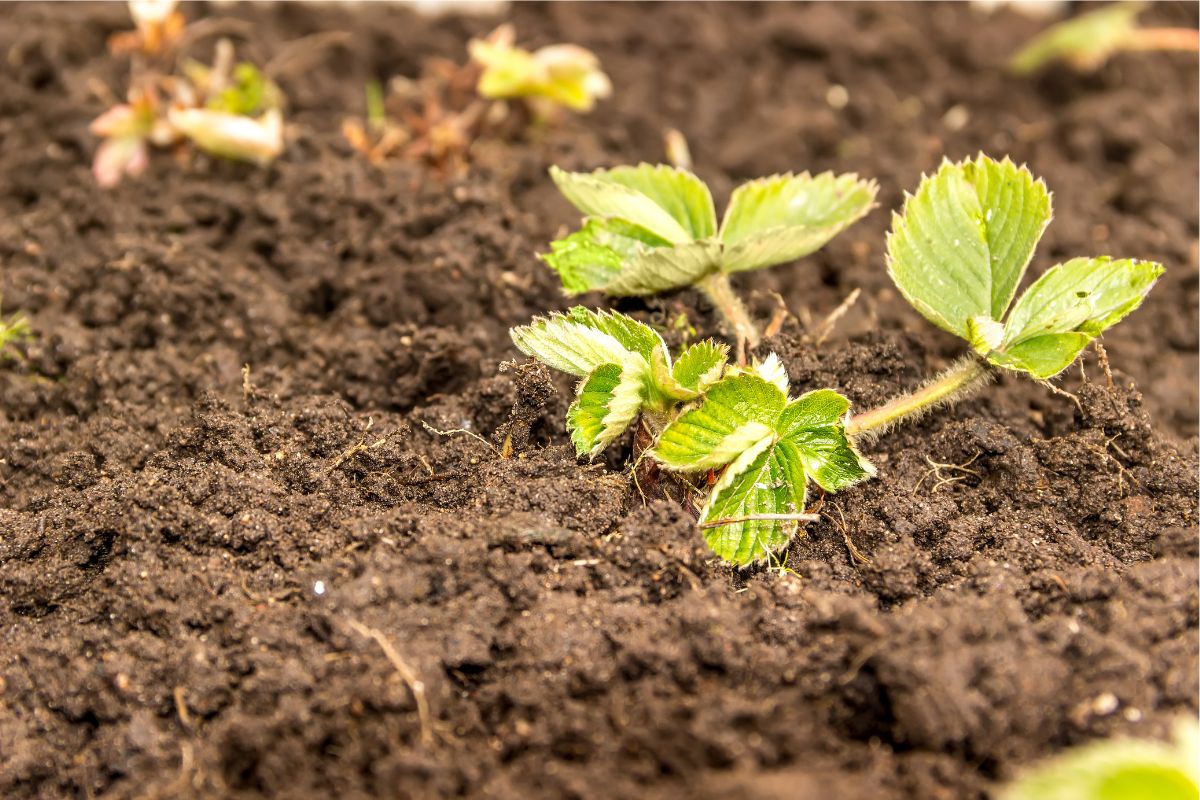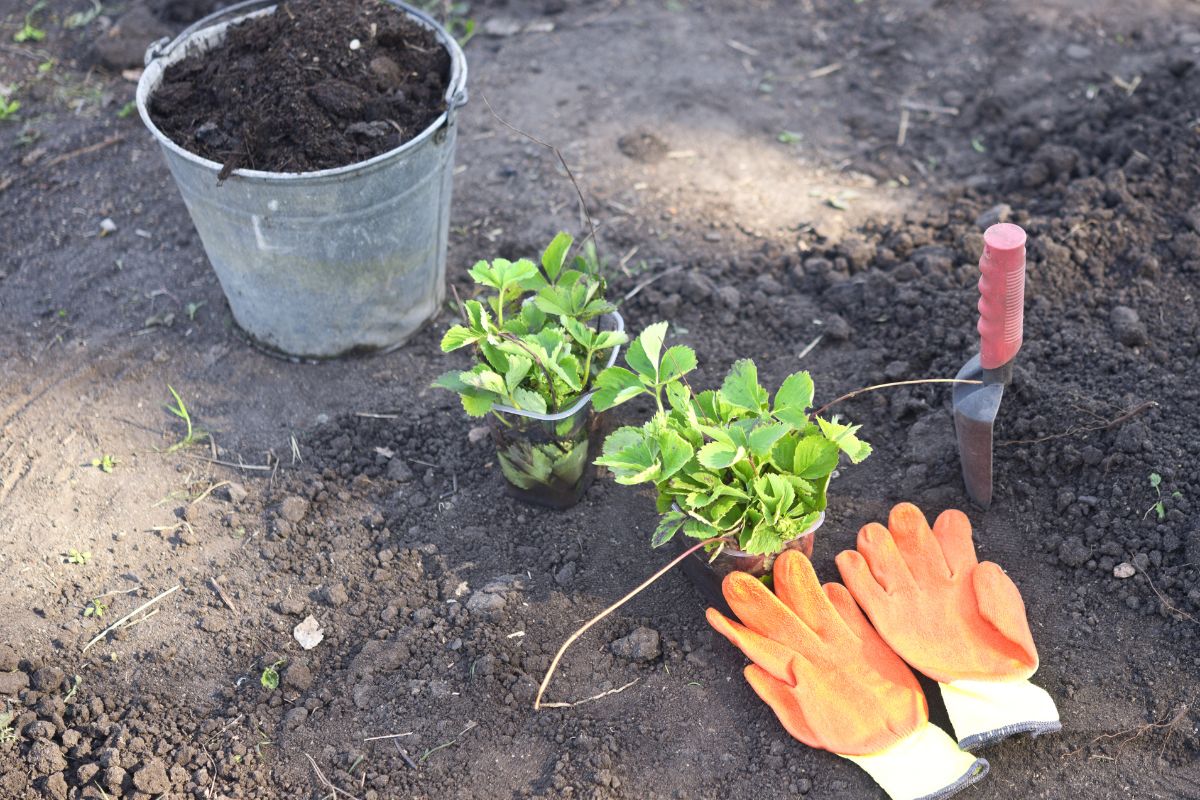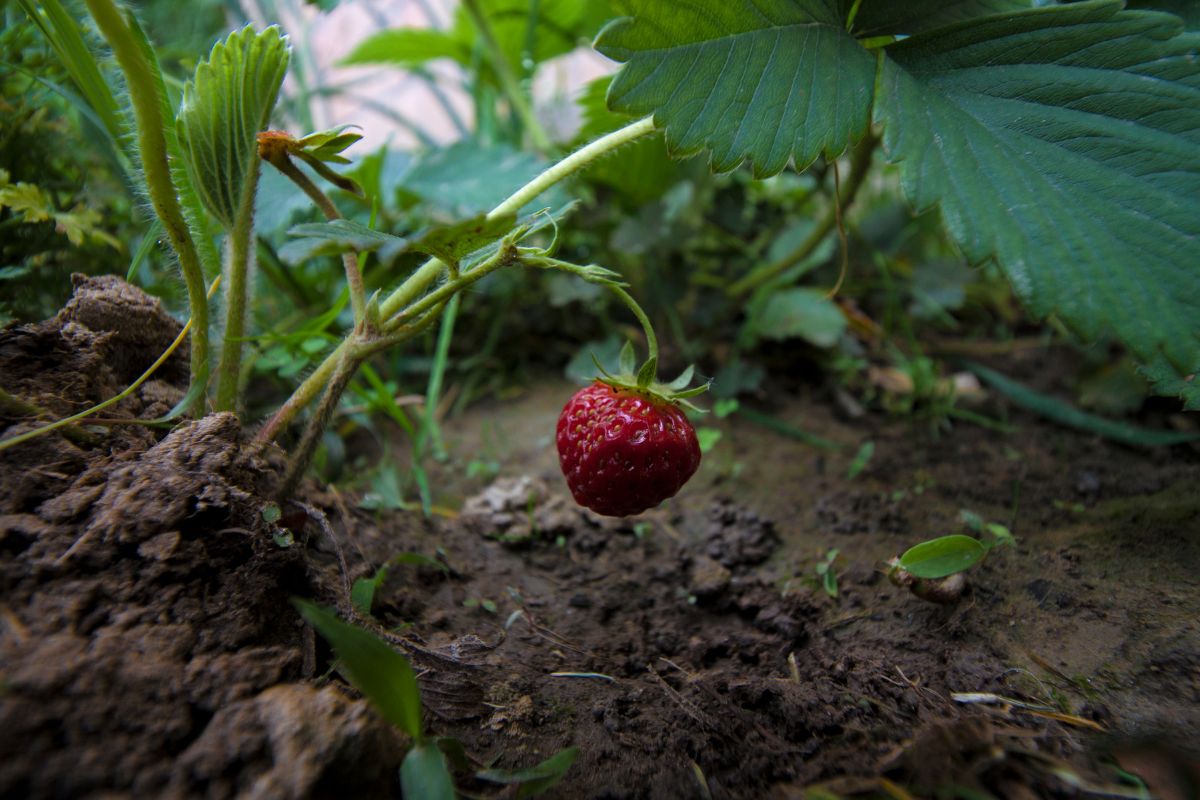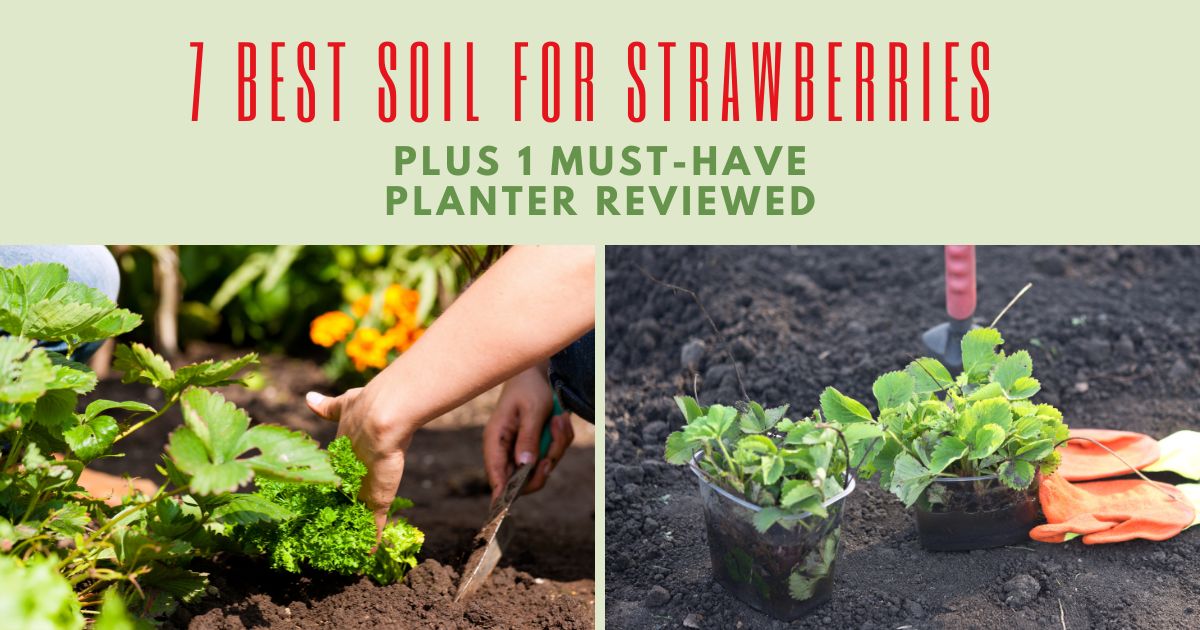Soil for Strawberries
Pick your planting location wisely. The best soil for strawberries is a deep, sandy loam rich in organic materials. The ground must have good drainage. Avoid any spots that are still damp well into the spring. The location has to have a moderate slope and ample sunlight. This enables cold air to escape the plants, reducing the risk of frost damage.

How to Grow Strawberries
Are you still questioning how to grow strawberries? Maintain mulch in strawberry beds to lessen water requirements and weed invasion. Any mulch will keep the soil moist and the plants tidy, including pine straw, shredded leaves, and black plastic.
Be thorough when weeding. Especially in the first several months after planting weed by hand.
Due to their weak roots, strawberries are very dependent on moisture. When the runners and flowers form again in the late summer when the plants are fully grown and preparing for winter hibernation, strawberry plants require a lot of water.
For vigorous growth, fertilize with all-purpose granules. Berries in warm climates ripen about 30 days following fertilization of blooms.
Pick off blossoms the first year to prevent strawberry plants from bearing fruit. If forbidden from producing fruit, they will use their food stores to build strong roots, which is advantageous. The second year will give substantially higher crops.
Remove runner plants as necessary. Higher yields are from the first and second generations. Try to maintain 10 inches ( 25.4 centimeters) separation between daughter plants. Using row coverings, you can keep birds away from fruit and flower blooms.
Avoid strawberry planting in recently grown potatoes, tomatoes, peppers, or eggplant areas because they harbor the Verticillium root rot fungus, which also affects strawberries.
Never plant strawberries in sod or grass that you recently plowed. This can result from devastating weed issues and damage from white grubs, a common turf insect that also eats strawberry roots.
Planting Strawberries
Allow enough room for sprawling. Space strawberry plants 18 inches (45.7 centimeters) apart to allow for runners, with a distance of 4 feet (1.21 meters) between rows. Strawberry plants spread quite widely. To accommodate the complete root system without bending it, dig planting holes that are both deep and wide enough.
Don’t plant too deeply, though. Although the crown should be near the soil’s surface, cover the roots. It is crucial to avoid burying the plant’s crown, which is its central growth bud, as doing so could cause it to rot. Fruit, flowers, and leaves need exposure to sunshine and clean air. Water plants well when you first plant them to help their roots take hold in the ground.
Strawberries can also grow from runners from the previous year. Read our article and find out Strawberries in Planters: The SECRET Revealed.
Are Strawberries Perennials?
Since strawberries are perennials, they will return every spring if the plants are healthy. While strawberry plant leaves may wither through the winter, their roots can withstand lower temperatures.
Every year, strawberry plants will reappear from their roots, assuming the roots are strong and able to withstand the winter. Although certain types can withstand the chilly winters of Zone 3, most strawberry plants are cold-hardy down to Zone 5.
Strawberry Plant Care
Strawberry plant care is crucial for your plants. Apply an all-purpose fertilizer as soon as your plants are in the ground and water them to give them a healthy start. It can be challenging, but removing all the flowers from your June-bearing plant during the first growing season is crucial, and waiting until early July removes blossoms from everbearing plants.
The plants will start to produce berries after removing these initial rounds. The plants produce better, larger berries when you pinch the first blossoms, which also strengthens the root systems of the plants. Avoid overwatering your berry plants, but make an effort to give them a daily average of 1 to 2 inches (2.5 to 5 centimeters) of water.
The ideal hoses to use are nearby drip or soaker hoses. Check to see if perennial weeds are present in the area where you will plant your strawberries, and try to avoid planting them where tomatoes, potatoes, peppers, or even strawberries were the previous two years. This will aid in preventing issues with root disease.
When berries ripen, gather them and use them in desserts or preserves, or freeze them for later use.
How we Picked our Favorites
We thoroughly investigated dozens of potting soil mixtures to develop the goods for this range. Because strawberries don’t enjoy standing in water, potting soil products had to drain properly, hold some moisture between waterings, and prevent compaction.
We also took the manufacturer’s standing into account. While Miracle-Gro, a famous brand nationwide for creating premium gardening supplies, is highly acclaimed, we also have some smaller businesses that produce premium mixes of the highest caliber.
Mixtures of soil that hold too much or too little moisture are not part of our list. The result is a selection of excellent items that can produce delectable strawberries.
How to Prepare the Soil for Strawberries
It pays to prepare the best soil for strawberries in advance and make arrangements for drainage, whether you plant in a garden, raised bed, or container.
If you’re growing strawberries in a container, fill the bottom of the pot with 1 to 2 inches (25.4 to 50.8 centimeters) of gravel. Then pour your preferable grow mix into the container.
Check the pH of the soil in a garden or bed to see if it is between the ideal range of 5.5 and 6.8. If not, improve the acid/alkaline balance by adhering to the modification suggestions included with the tester. If you aren’t using potting soil with nutrients or extra fertilizers, mix in an all-purpose fruit and vegetable fertilizer before planting.
The Best Strawberry Soil at a Glance
| Product | Best For Case |
| FoxFarm Strawberry Fields Flowering Garden Potting Soil, 1.5 Cubic Feet (2 Pack) | Best overall |
| EcoScraps for Organic Gardening Berry Plant Food, 4lbs | Best organic |
| Winchester Gardens Select Organics Berry Granular Fertilizer, 3-Pound Bag | Best granular |
| FoxFarms 733266 Soil, Strawberry Fields Potting, 1.5cu | Best for micronutrients |
| SunGro Black Gold All Purpose Natural and Organic Potting Soil Fertilizer Mix | Best for gardens and pots |
| Espoma Organic Berry-Tone-4-3-4 Natural & Organic Fertilizer and Plant Food for all Berries | Best Odorless |
| Mother Earth Perlite #3, Covers 4cu. ft., Large and Coarse, | Best for all berries |
What to Consider Before Buying Strawberry Soil
Strawberries can grow in various methods, but the most popular one is to put them in beds in the actual garden. But the plants won’t grow to their full potential if the soil doesn’t drain correctly. Ensure you settle for the best soil for strawberries.
Because they offer greater drainage, raised beds, strawberry towers, and containers are all suitable for growing strawberries. The pots can stay outside on a patio or balcony for easy picking and nibbling.
Strawberry TYpes
The huge variety of strawberry plants available may confuse a beginning gardener when choosing ones to cultivate at home. Both heirloom (ancient cultivars without hybridization) and contemporary cross-pollinated types that generate potent flavor falls under this category. Nevertheless, there are just three primary varieties of strawberries.
June-Bearing
As their name implies, these strawberries primarily bloom in June, perhaps a week or two earlier in warm southern climates and a week or two later in cooler northern temperatures. June-blooming strawberries are more suitable for garden beds and raised beds because they put forth runners, which result in enormous fruits and abundant harvests.
Everbearing
Strawberries of this variety give fruit twice during the growing season, in the late spring and again in the fall. Their fruits are marginally smaller than those of June-bearing bushes. They are the best choice for container plantings because they don’t send out runners. You will have the best harvest when you identify the best time to plant strawberries.
Day-Neutral
Day-neutral strawberries are a relatively recent addition to the strawberry family and bear fruit all year. However, they harvest their most substantial yields in late spring and fall. They are also appropriate for containers since they don’t dispatch runners.
Growing Area
Strawberries need at least 8 hours of direct sunlight each day, whether growing in beds or containers. Fruit production may be less if there is little sunlight, and strawberries may be small and flavorless.
Conceal your strawberries under a covering of foliage, but when they ripen, birds in the area may see them and swoop in to eat the vivid red fruits. While it can be challenging to keep birds away from strawberry patches, farmers can lessen the likelihood of a raid by placing strawberries far from other plants that attract birds, such as sunflower and marigold plants that produce seeds.
Growers can cover the plants with thin netting that allows light and water through if birds discover the fruits.
PH Value
Between 5.5 and 6.8 on the pH scale, slightly acidic soil is ideal for strawberries. The pH scale is from 0 to 14, with seven as neutral. Numbers higher than 7 are gradually more alkaline, whereas those below 7 are progressively more acidic.
In contrast to clay soil, which tends to be more alkaline, soil that is sufficiently rich in organic matter, such as compost made from vegetables or dry leaves, is more acidic. Before adding any supplements, home gardeners should test their soil; affordable pH testers are available online and in garden supply stores.
The pH of the soil can change by adding pulverized limestone to make it more alkaline or peat moss to make it more acidic. The pH of the existing soil determines the quantity of the existing soil, and many pH testers include suggestions for soil amendments.
Thankfully, most commercial soil mixtures fall within the pH range ideal for producing strawberries.
Drainage
Because strawberry plants can’t tolerate standing water, they won’t thrive in wet soil. The soil should drain fast while retaining moisture because the roots don’t want to be completely dry either.
The soil mixture contains components like Coco coir and Perlite that promote drainage, water absorption, and gradual water release. This prevents the roots from getting too dry in between waterings. Use only pots with drainage holes at the bottom for growing strawberries in containers.
Organic Substance
Like many garden plants, strawberries benefit from organic materials like dry leaves, bark, and compost. These organic materials biodegrade, which is the process by which they disintegrate and provide the soil with micronutrients.
Organic material is a common component of commercial soil mixtures. Examples include composted forest humus, coco coir, bark, and peat moss.
The term “organic matter” may appear on some soil mixtures merely refers to “plant-based” matter. An organic soil mix meets USDA standards for chemical-free manufacture. Additionally, it receives certification from the Organic Materials Review Institute (OMRI) that it exclusively contains natural ingredients (and no synthetic or chemical ones).

Our Tried-and-Tested Strawberry Soil Reviews
FoxFarm Strawberry Fields Flowering Garden Potting Soil, 1.5 Cubic Feet (2 Pack): Best Overall
Brand: Fox Farm
Style: Potting, garden
Weight: 77.8 pounds (35.3 kilograms)
Form: Granules
Organic: No
About This Item
- This potting mix aims to increase strawberry production by encouraging more flowers to bloom. A combination of sphagnum peat moss, coco coir, perlite, and mature forest products makeup FoxFarm’s fruit-specific potting mix, which keeps the soil light and well-draining while supplying ideal aeration and moisture retention.
- Earthworm castings, Bat guano, Dolomite lime, and oyster shells in powder form are all in the mixture to increase fruit size and bloom production. It is one of the best solutions for amending heavy garden or bed soil and a top pick for container planting because this particular FoxFarm blend contains more coco coir than competing mixes.
Product Specifics
- The ingredients include peat moss, coco coir, perlite, and mature forest products.
Added Nutrients
- Earthworm castings, bat guano, oyster shells, and dolomite lime.
Pros
- Lightweight for good drainage.
- It holds moisture.
- Increases the sprouting of flowers.
Cons
- It is pricey
EcoScraps for Organic Gardening Berry Plant Food, 4lbs: Best Organic
Brand: EcoScraps
Style: Potting, garden
Weight: 4 pounds (1.81 kilograms)
Form: Granules
Organic: Yes
About This Item
- It’s a formulation for berry plants such as blueberry, raspberry, strawberry, and others.
- One-piece design for a smooth, even, and simple application
- For uniform feeding, each particle has a complete assured analysis.
Product Specifics
- It includes leftovers that recycle throughout the food life cycle.
Added Nutrients
- It is free of additional nutrients.
Pros
- It is organic.
- Does not contain additives.
Cons
- It is expensive
Winchester Gardens Select Organics Berry Granular Fertilizer, 3-Pound Bag: Best Granular
Brand: Winchester Gardens
Style: Potting, garden
Item Weight: 3 pounds (1.36 kilograms)
Form: Granular
Organic: Yes
About This Item
- Excellent for most indoor and outdoor plants in your garden promote development everywhere.
- The package contains a spoon.
- It is excellent for most of your garden’s indoor and outdoor plants.
- It promotes overall growth.
Product Specifics
- Compressed coco coir is a component.
Added Nutrients
- Fertilizer
Pros
- drains incredibly well
- maximum moisture retention
- Plants feed for up to six months.
Cons
- Fertilizer is artificial.
FoxFarms 733266 Soil, Strawberry Fields Potting, 1.5cu: Best For Micronutrients
Amazon’s Choice in Garden Soil by FoxFarms
Brand: Fox Farm
Style: Potting, garden
Item Weight: 77.8 pounds (35.3 kilograms)
Form: Granular
Organic: No
About This Item
- The pH-balanced potting mix that FoxFarm sells makes it much simpler to cultivate flavorful strawberries. This potting soil consists of peat moss, perlite, and forest humus, and it has excellent drainage and aeration thanks to the combination of those three ingredients.
- In addition, the mixture assures that the soil will keep its hydration even between irrigations.
- Microbes and micronutrients such as bat guano, earthworm castings, oyster shells, and humic acid are part of this mixture, which intends to encourage increased flower and fruit production.
- The soil also has leonardite, which is a natural soil conditioner. When combined with the oyster shells, these two components provide a pH between 6.3 and 6.8, which places the soil within the ideal range for producing strawberries.
Product Specifics
- Contains microbes and micronutrients, including earthworm castings, oyster shells, humic acid, peat moss, perlite, forest humus, soil conditioner, and bat guano.
Added Nutrients
- Microbes and micronutrients; humic acid, bat guano, earthworm castings, oyster shells.
Pros
- Highly nutritious
- Drains well
- Has added natural nutrients.
Cons
- Quite expensive.
SunGro Black Gold All Purpose Natural and Organic Potting Soil Fertilizer Mix: Best For Gardens and Pots
Brand: Sun Gro
Style: Peat moss, bark, potting
Item Weight: 15.7 pounds (7.12 kilograms)
Form: Spikes
Organic: No
About This Item
- Perfect for raising beds, window boxes, patio planters, hanging baskets, and other outdoor and indoor containers.
- The ideal growing medium is for all of your gardening needs, including annuals, perennials, veggies, herbs, and house plants; this growing medium is perfect.
Product Specifics
- Offers the best strawberry plant care and protection for retention from ongoing exposure to heat, wind, and sun.
Added Nutrients
- Includes compost, aged or composted bark, earthworm castings, sphagnum peat moss from Canada, horticultural grade perlite, pumice, cinders, and organic grade fertilizer
Pros
- Perfect for both gardens and pots.
Cons
- It is not natural.
Espoma Organic Berry-tone 4-3-4 Natural & Organic Fertilizer and Plant Food for all Berries: Best For All Berries
Brand: Fruit & Berry Food
Style: Potting, garden
Item Weight: 4 pounds (1.81 kilograms)
Form: Sticks
About This Item
- Suitable for all berries, including blueberries, strawberries, raspberries, and blackberries
- Berry-tone has no sludges or hazardous substances, making it environmentally safe.
- When planting or feeding established plants, it is recommendable to use Berry-tone fertilizer; most berries benefit from two feedings per year, in the early and late spring. Berry-tone is ready and doesn’t need mixing.
- Berry-tone is acceptable for use in organic gardening because it is a recognizable organic input material, which means it complies with all standards for organic production.
Product Specifics
- Berry-tone is a potent combination of the finest natural and organic components strengthened with our Bio-tone formula; 4-3-4 Fertilizer analysis with 5% Sulfur.
Added Nutrients
- Berry-tone has no sludges or hazardous substances.
Pros
- Suitable for all berries.
- It Does not need mixing.
Cons
- Has high prices.
Mother Earth Perlite #3, Covers 4cu. ft., Large and Coarse: Best Odorless
Brand: Mother Earth
Style: Garden
Item Weight: 13.6 pounds (6.17 kilograms)
Form: Perlites
About This Item
- A growing medium with no smell, Mother Earth Perlite has a pH of 7.0.
- Adds porosity to soil and soilless mixtures; it is one of the largest perlites on the market.
- There are several hydroponic uses for Mother Earth Perlite.
Product Specifics
- Features naturally occurring siliceous rock that, when you heat it to 1,600 degrees Fahrenheit (871 degrees Celsius), can expand up to 20 times its initial volume.
Added Nutrients
- No added nutrients.
Pros
- Has no smell.
- It can expand up to 20 times if you heat it.
Cons
- Not suitable for potting.
Plus
Stacky 5-Tier Strawberry Planter Pot, 5 Pots: Best Planter
Amazon’s Choice in Planters by Mr. Stacky
Brand: Mr. Stacky
Material: Plastic
Color: Terracotta Orange
Style: Modern
Shape: Novelty
About This Item
- It is a free stand and can fit in any place
- It uses a pipe to build grow towers off the ground effortlessly.
- It is food-safe, strong, flexible, and lightweight.
- You can use it indoors or outdoors.
- You can grow herbs, flowers, succulents, and strawberries in small spaces.
- It has a flow-through design that prevents root rot or overwatering. You only water 1 top pot and take care of 20 plants.
Pros
- You can manage 5-tier plants at the same time.
- It is strong enough to accommodate the plants.
Cons
- It is expensive.

The Final Say on Strawberry Soil and Planters
Any potting soil choices in this review are excellent choices for growing delicious strawberries. Still, FoxFarm Strawberry Fields Flowering Garden Potting Soil, 1.5 Cubic Feet (2 Pack), is the clear winner since it offers the best drainage, aeration, and moisture retention.







